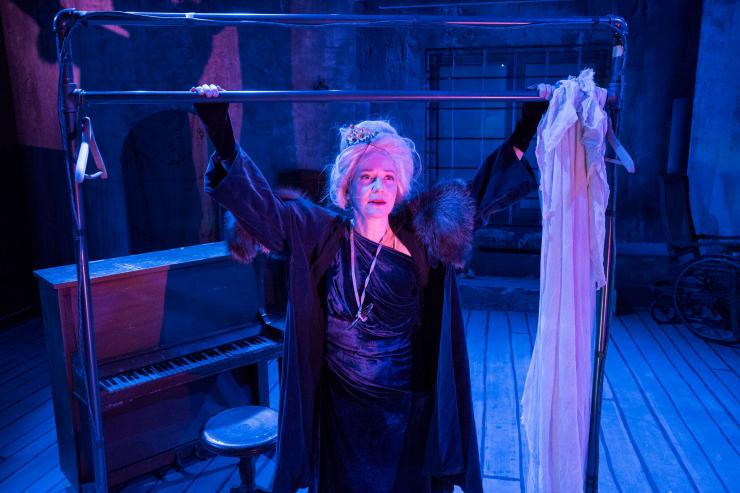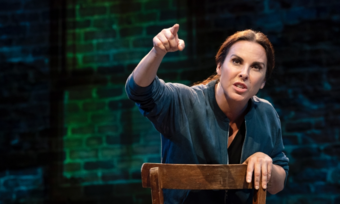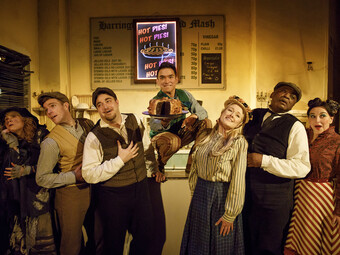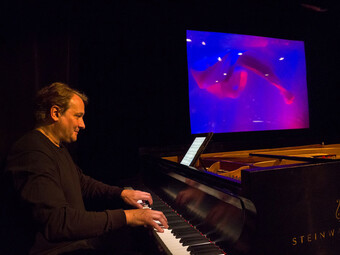Tennessee Williams, Mary Shelley, Lord Byron, and Cockroaches Glass Guignol
The Brother and Sister Play
In its forty-seventh year, Mabou Mines is inaugurating its first permanent home, the ninety-nine-seat Mabou Mines Theater in the East Village, with a newly devised piece called Glass Guignol: The Brother and Sister Play, a riff on Tennessee Williams that presents passages from four of his plays, most prominently The Glass Menagerie. But to summarize the piece in such a straightforward way fails to capture the elusiveness of the work by this celebrated avant-garde theatre company. Glass Guignol makes the recent, critically bludgeoned, experimental The Glass Menagerie directed by Sam Gold on Broadway feel like a production for the Hallmark Hall of Fame.
Directed by Lee Breuer, the eighty-year-old co-founder of the company, Glass Guignol focuses on two characters and their complex relationship: The Brother (portrayed by Greg Mehrten, himself a fixture in downtown theatre since 1975) and The Sister (Maude Mitchell, a Mabou Mines “artistic associate,” and longtime collaborator with Breuer, who conceived and adapted this piece with him.) These two characters are stand-ins for Tennessee Williams and his sister Rose, who was the object of his love, pity, compassion and guilt—the inspiration for Laura in the Glass Menagerie. The Brother and the Sister are in turn playing roles: The Brother is Felice, the cross-dressing playwright and actor/manager of a company on tour; the Sister is Clare, Felice’s sister and co-star.

At points throughout the piece, Clare recites lines Williams wrote for Laura in The Glass Menagerie, and Felice for both Amanda Wingfield and her son Tom.
But the speeches are preceded, succeeded, and interwoven with:
Two men in gorilla suits, one wearing a tutu.
A life-sized statue of Jesus on the cross, eventually replaced on the cross by a living young actor, wearing only a diaper.
An entire second act apparently set in an insane asylum.
The Sister climactically fitted with monster arms and monster feet; the monster feet remain on stage at the conclusion of the play.
A puppet of Mary Shelley, who sometimes recites lines from her own novel, Frankenstein, and sometimes uses her cell phone to text Lord Byron, depicted as a bust on a pedestal to which his own cell phone is attached (a creation of puppeteer Basil Twist, who, like Breuer, is a MacArthur Foundation “genius” grant winner).
If Mabou Mines’s latest work as a whole remained elliptical to me, nearly everything in it also struck me as familiar.
What Mary Shelley initially texts Lord Byron is an explanation of what Mabou Mines is doing in Glass Guignol: It is an “essay play contrived of Readymades,” Shelley writes, her text projected onto makeshift screens placed throughout the stage.
“Readymades?” Byron texts back.
Shelley: “In the art world, a readymade is a familiar object that becomes a work of art by the act of placing it in an unfamiliar context, like the placing of a urinal on a pedestal in an art gallery.” We see a projection of Mary’s exact example, cheekily entitled Fountain (1917), by the pioneering modern artist Marcel DuChamp.
Shelley continues: “The Brother and Sister Play pretends there are such things as ‘Literary Readymades.’ For example, iconic passages of Williams’s dialogue reframed in an unfamiliar context tell a hidden story of his sister Rose.”
This explanation might have lifted Glass Guignol into a cloudless clarity, if I were the type of person who had gotten a PhD in performance studies, or even just felt comfortable using words like “performativity.”
Nevertheless, if Mabou Mines’s latest work as a whole remained elliptical to me, nearly everything in it also struck me as familiar.

As I’ve written before (most recently for HowlRound), I grew up on Mabou Mines, which Breuer, his wife Ruth Maleczech and several others founded in 1970 in the East Village, naming it after a coal mining town in Nova Scotia where they for some reason rehearsed their first original production, The Red Horse Animation. The first show of theirs I saw was a production of short plays by Samuel Beckett, full of strangely timed blackouts, odd dreamlike recitations, and bouts of nudity. What was going on was just outside my comprehension, the way a word can be on the tip of your tongue, but I was intrigued.
As an audience member, I have to admit that I don’t always know what they are doing in Glass Guignol—their main effort seems to be to explore the line between reality and imagination.
Then, in the 2003 production of Mabou Mines Dollhouse, an adaptation of Ibsen’s play, all the male characters were portrayed by actors under four-and- a-half feet tall, and all the women, who were close to six feet tall, had to crouch to enter into the literal doll’s house constructed to accommodate the men.
Maleczech, who died four years ago, apparently never liked the term experimental theatre; experimental, she said, “makes it sound like you don’t know what you are doing.”
The “you” she is talking about, of course, is herself, and the other theatre artists. As an audience member, I have to admit that I don’t always know what they are doing in Glass Guignol—their main effort seems to be to explore the line between reality and imagination. As with their previous experiments, however, there are moments that stick with me. Many of them are visual, but then there were the headline-like excerpts from the harsh reviews that Williams received late in his career, recited by both Shelley and Byron:
‘Sicker than necessary.’— the New York Times
‘Played out?’—Life Magazine
And then Maude Mitchell gives herself a monologue about cockroaches, prompted by the observation that they are immune to radiation and so are destined to outlive human beings: “After some centuries, there’s going to be cockroach actors and actresses and cockroach playwrights and cockroach artist management and—cockroach audiences...”
Is this an optimistic or pessimistic prophecy?
In any case, the more immediate future is looking up for the human members of Mabou Mines and their friends and associates, in their theatre in the newly renovated 122 Community Center (122CC), formerly Public School 122, on 9th Street and 1st Avenue. After Glass Guignol, there will be a ribbon cutting, and then something approaching a full season, including a new program entitled “SUITE/Space” to showcase “artists from historically underrepresented communities, who share Mabou Mines’s commitment to breaking new ground in form and content.”
Jonathan Mandell’s NewCrit piece usually appears the first Thursday of each month. See his previous pieces here.








Comments
The article is just the start of the conversation—we want to know what you think about this subject, too! HowlRound is a space for knowledge-sharing, and we welcome spirited, thoughtful, and on-topic dialogue. Find our full comments policy here